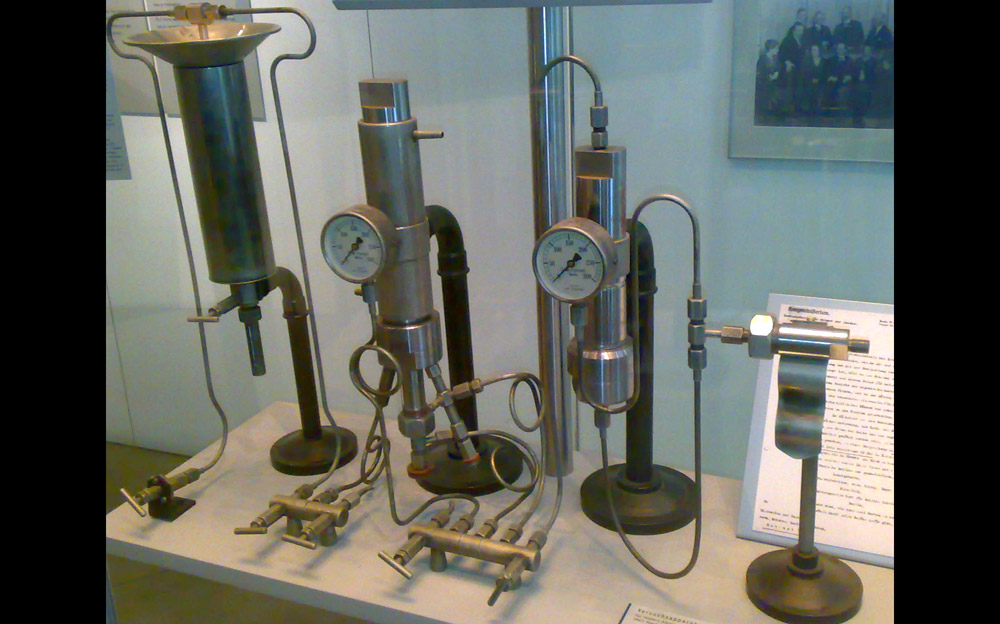For the first time, chemists have taken a critical step in the synthesis of ammonia in the directly visible Haber-Bosch process – the binding of a nitrogen molecule (N2) to the catalytic converter. Using a scanning tunneling microscope, they observed how the molecules bonded to each other and how this changed their orientation and bonding. This step is the prerequisite for breaking the strong triple bond in the nitrogen molecule and thus also for the rest of the ammonia synthesis.
The manufacture of ammonia, developed by German chemists about 100 years ago using the Haber-Bosch process, is still the basis for the production of a large part of the fertilizers used around the world, as well as other chemical products. The stable triple bond of the nitrogen molecule is first broken down using pressure, heat, and catalysts, so that the nitrogen can then react with hydrogen to form ammonia (NH).3) can interact.
The energy required for this multistep synthesis is significant: the Haber-Bosch process is responsible for about one percent of global energy consumption and 1.4 percent of carbon dioxide emissions. Interest in improvements or alternatives to this process is correspondingly high.
The reaction between the catalyst and nitrogen under the microscope
Zhao Zhang at the University of Pittsburgh and colleagues have now gained first-hand insight into one of the critical steps in the Haber-Bosch process. For the first time, they directly observed what happens when a nitrogen molecule binds to one of the catalysts involved in the reaction. They explain: “In the synthesis of ammonia, catalysts in the form of alkaline atoms facilitate the dissolution of nitrogen.” “This is the specific step in the process chain.”
However, since the decomposition of nitrogen in the Haber-Bosch process occurs under heat and pressure, direct observation, for example with a scanning tunneling microscope (STM), is impossible – molecules and atoms move around a lot. So Zhang and his team chose a different approach: They observed what was happening under conditions that did not allow nitrogen to disintegrate, but the processes leading up to it do.
For their study, they placed individual catalyst atoms in the form of potassium on an inert silver surface and cooled the array to minus 268 degrees. Then they passed nitrogen gas over it and observed what was happening at the atomic level using a scanning tunneling microscope.

Potassium becomes attractive
It turned out that before the arrival of nitrogen, the potassium atoms were at a regular distance from 0.90 to 0.99 nm on the surface of the silver. Measurements using the tip of the STM showed that one of the outer electrons of potassium is strongly drawn to the silver. Chemists write: “At low coverage, potassium is almost completely ionized.” Thus the catalyst atom bears a partial positive charge.
This creates an important prerequisite for the accumulation of nitrogen: the potassium atoms of the electron-rich nitrogen molecule present a positive counterpoint and thus attract it. come now2 In addition, the bright, regular sequence of potassium atoms changes: As nitrogen molecules stick to potassium, increasingly dark spots appear, the team noted.
Charge transfer impairs nitrogen fixation
Careful analysis revealed exactly what’s going on: a nitrogen molecule is attached to an atom in such a way that the three atoms form a straight line. “The axis of the ANN runs roughly parallel to the surface and the end of the nitrogen points to the adjacent potassium atom,” Zhang and his team report. If there are many nitrogen molecules, they prefer to contact directly adjacent potassium atoms with each other and point their ends away from each other.
This bond leads to the exchange of partial charges between the catalyst, the surface and nitrogen, which strengthens the electrostatic forces of attraction between potassium and nitrogen and at the same time weakens the triple bond between the N atoms, as chemists determined with the help of Model. “The pairwise interaction between potassium and nitrogen is caused by a bicentric Coulomb electrostatic attraction,” they say.
The starting point for further research
This is the first time that researchers have directly observed and sampled the processes and reactions that immediately precede nitrogen cleavage in the Haber-Bosch process. Not only does this provide key insights into this important step, but it can also provide valuable clues about where and how to improve this process. (Physical Science of Cell Reports, 2022; doi: 10.1016/j.xcrp.2022.100865)
Source: University of Pittsburgh

“Total coffee aficionado. Travel buff. Music ninja. Bacon nerd. Beeraholic.”








More Stories
Coral Seeding: Artificial Insemination Makes Coral More Heat Tolerant
Fear, Anger, and Denial: How People Respond to Climate Change – Research
LKH Graz: Using radiation to combat heart arrhythmias